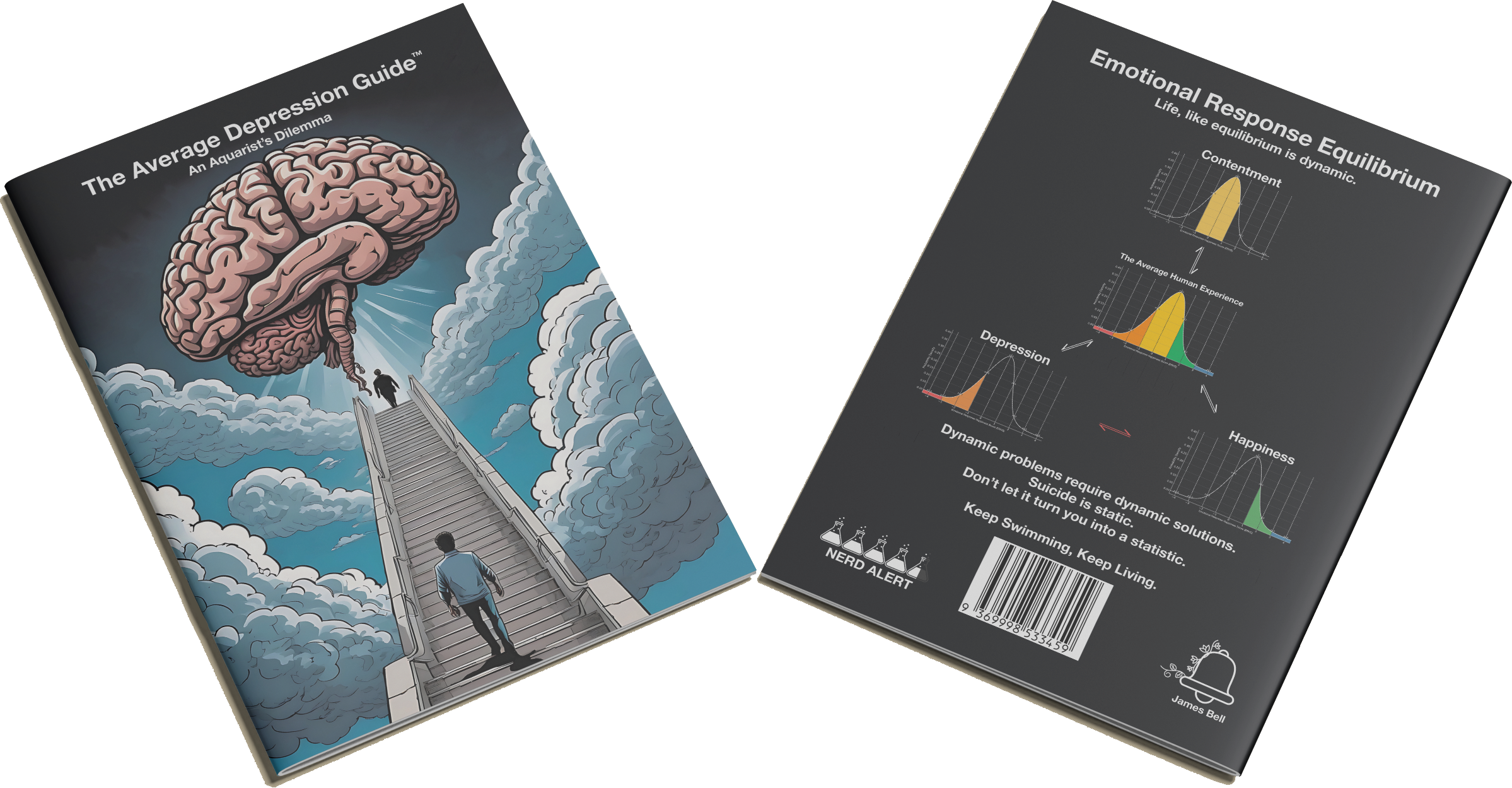 Image 1 of 4
Image 1 of 4

 Image 2 of 4
Image 2 of 4

 Image 3 of 4
Image 3 of 4

 Image 4 of 4
Image 4 of 4





The Average Depression Guide™
Whether you have depression yourself, know someone who does, or want to learn about it to be better aware of the signs for the ones you love, The Average Depression Guide is a thought provoking insight into this complex illness.
This guide has been written to help improve the understanding and management of depression by providing tools to express your feelings, making it easier to communicate with a therapist if needed.
The way we do this is through our original ‘Emotional Response Equilibrium’ analogy. It sounds more complex than it actually is, so hear me out.
The Emotional Response Equilibrium analogy is based off an old chemistry principle which states that ‘if a system at equilibrium is subjected to change, it will adjust itself to partially counteract that change’.
So, if we are in a constant period of depression, instead of trying hard to make sudden, big changes which may leave us feeling tired and trapped in our own minds…why don’t we use principles of Science to slowly beat this complex illness?
This guide is motivational without giving you the fake motivational ick, nerdy enough so you’ll learn something new but not too nerdy where you’ll have to google every second word.
At 52 pages, it is short enough not to be intimidating but long enough to be insightful with thoughtful illustrations throughout to provide visual representations of the core ideas being explained.
There is no substitute for therapy and there is no substitute for you.
Keep Swimming, Keep Living.
The Average Depression Guide is sold as a hard copy.
I am not a licensed therapist, psychiatrist or psychologist, and therefore lack the qualifications to provide therapy. However, the aim of this guide is to destigmatise seeking professional help, so you can put yourself in the hands of qualified experts who can help you when you need it most.
Whether you have depression yourself, know someone who does, or want to learn about it to be better aware of the signs for the ones you love, The Average Depression Guide is a thought provoking insight into this complex illness.
This guide has been written to help improve the understanding and management of depression by providing tools to express your feelings, making it easier to communicate with a therapist if needed.
The way we do this is through our original ‘Emotional Response Equilibrium’ analogy. It sounds more complex than it actually is, so hear me out.
The Emotional Response Equilibrium analogy is based off an old chemistry principle which states that ‘if a system at equilibrium is subjected to change, it will adjust itself to partially counteract that change’.
So, if we are in a constant period of depression, instead of trying hard to make sudden, big changes which may leave us feeling tired and trapped in our own minds…why don’t we use principles of Science to slowly beat this complex illness?
This guide is motivational without giving you the fake motivational ick, nerdy enough so you’ll learn something new but not too nerdy where you’ll have to google every second word.
At 52 pages, it is short enough not to be intimidating but long enough to be insightful with thoughtful illustrations throughout to provide visual representations of the core ideas being explained.
There is no substitute for therapy and there is no substitute for you.
Keep Swimming, Keep Living.
The Average Depression Guide is sold as a hard copy.
I am not a licensed therapist, psychiatrist or psychologist, and therefore lack the qualifications to provide therapy. However, the aim of this guide is to destigmatise seeking professional help, so you can put yourself in the hands of qualified experts who can help you when you need it most.
Whether you have depression yourself, know someone who does, or want to learn about it to be better aware of the signs for the ones you love, The Average Depression Guide is a thought provoking insight into this complex illness.
This guide has been written to help improve the understanding and management of depression by providing tools to express your feelings, making it easier to communicate with a therapist if needed.
The way we do this is through our original ‘Emotional Response Equilibrium’ analogy. It sounds more complex than it actually is, so hear me out.
The Emotional Response Equilibrium analogy is based off an old chemistry principle which states that ‘if a system at equilibrium is subjected to change, it will adjust itself to partially counteract that change’.
So, if we are in a constant period of depression, instead of trying hard to make sudden, big changes which may leave us feeling tired and trapped in our own minds…why don’t we use principles of Science to slowly beat this complex illness?
This guide is motivational without giving you the fake motivational ick, nerdy enough so you’ll learn something new but not too nerdy where you’ll have to google every second word.
At 52 pages, it is short enough not to be intimidating but long enough to be insightful with thoughtful illustrations throughout to provide visual representations of the core ideas being explained.
There is no substitute for therapy and there is no substitute for you.
Keep Swimming, Keep Living.
The Average Depression Guide is sold as a hard copy.
I am not a licensed therapist, psychiatrist or psychologist, and therefore lack the qualifications to provide therapy. However, the aim of this guide is to destigmatise seeking professional help, so you can put yourself in the hands of qualified experts who can help you when you need it most.